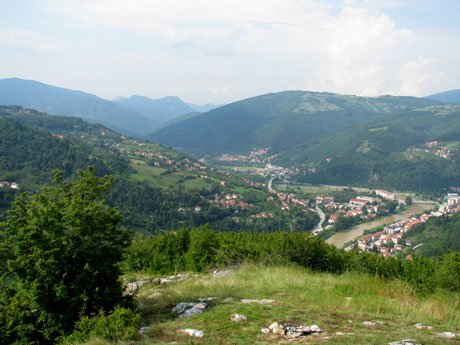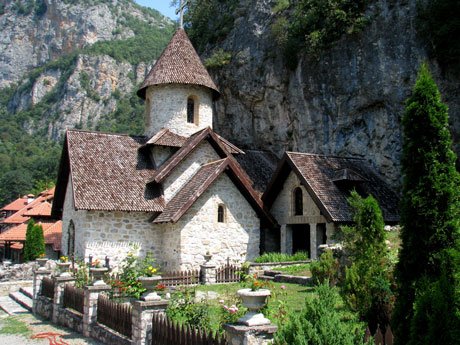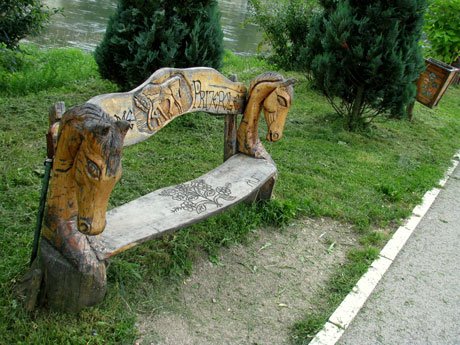
If you need a freelance travel writer or you would like to see your country, city, flight, etc., presented on the blog, drop me an email.
Find our more on Freelance Travel Writer page.
Here are some things to do in Prijepolje, Serbia. Whether you’re drawn to religious monuments, stunning landscapes, or adrenaline-fueled adventures, this destination offers it all. Expect to create unforgettable memories and take home some truly surreal photographs!
FROM BELGRADE: about 290 km
FROM NIS: about 300 km
When you mention Prijepolje to Serbian locals, the first thing that often comes to mind is the Mileševa Monastery. However, there is so much more to explore in the area. From the picturesque village of Kamena Gora to the medieval Mileševac Fortress—complete with Sava’s Cave beneath it and the 400-year-old Quran in the local mosque—you’ll find plenty to fill your itinerary. And don’t forget to hike up to the Sokolica observation deck or visit the breathtaking Sopotnica waterfalls.
During my visit, I was persistently chased by rain while trying to explore western Serbia. Yet, despite the ever-changing clouds, I managed to discover most of the landmarks and natural wonders that Prijepolje, Serbia, has to offer.

Mileševa Monastery
The Mileševa Monastery is the endowment of King Vladislav, the grandson of the famed Serbian prince, Stefan Nemanja. Construction began in 1218, but the monastery gained widespread recognition 19 years later when the body of Saint Sava the Enlightener was moved and buried there. Saint Sava, the son of Stefan Nemanja, was a Serbian prince and Orthodox monk. His relics were later transferred to Belgrade in 1595 under Ottoman orders and tragically burned.
The monastery also became notable for housing a printing press in the 16th century. However, its most celebrated relic is undoubtedly the White Angel fresco (Beli Anđeo) from the 13th century. Widely regarded as one of the most exquisite pieces of medieval Serbian and European art, this fresco gained global fame when it was included in the first transatlantic television signal broadcasted from Europe to the U.S. in 1962. The White Angel was part of a greeting message sent to Space, alongside images of the Moon landing and the Great Wall of China, symbolizing peace and humanity’s artistic legacy.
This wasn’t my first visit to Mileševa, but no matter how many times I’ve been, I can’t resist the pull of standing before the White Angel again. The fresco is renowned for creating the uncanny illusion that the Archangel Gabriel’s gaze follows you wherever you move. (I had a similar feeling when viewing Da Vinci’s Mona Lisa at the Louvre in Paris. See the travelogue about my trip to France.)
It’s fascinating to reflect on details about the fresco’s history. For instance, it was hidden beneath another painting in the 16th century and rediscovered only in the 20th century during restoration. Praised for its impeccable composition—rare for medieval times—it has also inspired various beliefs and legends surrounding its miraculous qualities.

Today, visitors can even stay overnight at the monastery which is an experience for itself. (I did just that a couple of years later, read more in the post about West Serbia Tourist Attractions.)
As I wandered past groups of tourists vying for the perfect shot of the monastery’s pristine white domes nestled by a rushing river, another sight caught my attention. Behind me loomed a towering hill crowned with the ancient ruins of the Mileševac Fortress—a reminder of the region’s deep historical roots.

Mileševac Fortress
The remnants of this old town can be found at the end of the Mileševka Gorge, beneath the village of Hisardžik. In 1373, these lands were divided between Serbian Prince Lazar and Bosnian King Tvrtko, marking the period when the Old Town fell under Bosnian rule. Once a formidable fortification, it served to protect not only the nearby monastery but also merchants and caravans passing through. Recognizing its strategic position, the Ottomans later established a military base here in the 15th century.
This medieval town is also notable for its proximity to St. Sava’s Cave and a mosque that houses an extraordinary artifact—a 400-year-old Quran, written entirely by hand.

The road to Mileševac is winding and steep, but the stunning landscape that greets you at the top makes every twist, turn, and unpaved trail more than worthwhile. (It’s no wonder this fortress tops any things-to-do list in Prijepolje Serbia.) The day I visited, the Old Town was shrouded in a massive gray cloud, which only added to the surreal ambiance. As soon as I reached the fortress walls, it became immediately clear why this was such a significant place. The panoramic view stretches an impressive 360 degrees!
Beneath the imposing walls lies a small, white mosque. I was fortunate enough to be invited inside by local workers who were paving the trail to the fortress and happened to hold the key. Inside, the 400-year-old Quran sat elegantly on a stand, illuminated by soft light streaming through a small window, accentuating the delicate strokes of the Arabic script.
From there, I took a narrow path winding around the hill, leading to another observation point overlooking the gorge and eventually to St. Sava’s Cave. It’s almost unfathomable how monks once navigated this rugged terrain without the safety of the modern fence that now lines the trail. They are said to have painstakingly copied ancient manuscripts here.

Inside the cave, a spring flows—a source of mystery and local legend. According to tradition, those who are unkind or unworthy find that the water eludes them, vanishing before their eyes. Another tale suggests that the spring runs dry temporarily after being used by sinners. Locals have long believed that the so-called St. Sava’s Water has healing properties, particularly for ailments of the eyes.

Davidovica and Kumanica
The Church of Davidovica, dedicated to the Baptism of Christ, was built by a monk named David, whose grandfather was Serbian Prince Stefan Nemanja. This familial connection gives the monastery its name. The monastery remained active until the 17th century, after which it was demolished by the Turks. Despite this, locals continued to visit the site to pray. During 20th-century excavations, an older structure was discovered beneath the church—likely a Roman basilica from the 6th century. Archaeologists also uncovered a grave monument connected to the father of Serbian Princess Milica from the 14th century. In total, eight graves were found, believed to be the final resting place of the famous Jugović brothers, who perished heroically during the Battle of Kosovo in 1389. According to tradition, their remains were interred here by Princess Milica herself.
The Kumanica Monastery, featuring the Church of St. Archangel Michael, dates back to the 14th century and has been a revered sanctuary throughout history. This monastery once housed the Kumanica Gospel, an inscription that dates to the 16th century. Believers often claim the monastery possesses healing powers.

You don’t have to be an Orthodox Christian—or even religious—to deeply appreciate these 13th and 14th-century monasteries. The very thought of these ancient walls standing tall for centuries, revered by countless generations, is humbling. Visiting them is a must for anyone exploring Prijepolje Serbia. The journey to Kumanica is an adventure in itself; you’ll cross the border into Montenegro, and after about ten minutes, a bridge on your left leads you back onto Serbian soil, where the monastery awaits.

During my visit, I washed my face and drank some of the allegedly miraculous water, as is customary when visiting the monastery. I also enjoyed a few traditional cookies, lovingly prepared by the nuns to welcome guests. Towering cliffs loomed above us, while a fast-flowing river roared below—a dramatic and awe-inspiring setting.

By contrast, the Davidovica Monastery sits gracefully on a verdant hill, surrounded by towering mountain ranges. The elegant white structure stands out strikingly against its natural surroundings. I couldn’t help but reflect on the possibility that those 14th-century Serbian heroes were buried here, and centuries later, I was walking the same ground, admiring the same breathtaking view.

For history enthusiasts, there’s another hidden gem near Prijepolje Serbia. On the outskirts of the town, in the village of Hrta, you can visit a medieval necropolis dating back to the 14th and 15th centuries. Known as the Greek Graveyard, this site features intricately carved stone monuments and richly decorated sarcophagi—a fascinating testament to the region’s historical depth.

Sopotnica Waterfalls
Sopotnica Nature Park is located 17 km from Prijepolje, Serbia, at an altitude of 1,000 meters. At its source, the river forms numerous small cascades that merge into three larger flows, creating breathtaking waterfalls over 20 meters high. This picturesque spot is also home to unique traditional mills, once used by locals to grind grain. The village is renowned for its delicious lamb, flavorful cheese, the traditional Serbian drink rakija, honey, and homemade pies.

I had visited these waterfalls before, but I couldn’t resist returning this year. For hiking enthusiasts, there’s a steep and rewarding trail; however, I opted to drive, enjoying the scenery as I went. Imagine this: you’re driving uphill when the road suddenly curves left, leaving you with the thrilling illusion that the car might soar over the lush green hills if it continued straight ahead.

At the top, you’re greeted by the invigorating splash of freshwater cascading down moss-covered rocks, set against a surreal landscape. The hilltop offers mesmerizing views of the old mills nestled in their tranquil surroundings. Just take a moment to absorb this beauty, and imagine what you’d be missing if you didn’t venture here from Prijepolje, Serbia.
Kamena Gora Serbia
Kamena Gora is often hailed as the most beautiful village near Prijepolje, Serbia, nestled at altitudes ranging from 800 to 1,496 meters. Located just 20 km from the town, this nature reserve boasts more than 100 springs and is celebrated for its clean, crisp air. The village’s crown jewel is an ancient pine tree, over 400 years old, revered by locals.

When Milan from the local Tourism Organization described the pine tree’s historical and mystical significance in Serbian tradition, I couldn’t wait to see it for myself. To make the experience even more special, Milan revealed that his family originated from Kamena Gora, making him the perfect guide for this little adventure.

The winding road ascends through rolling hills, but the most stunning view awaits near the ancient pine tree. The vast mountain range in the distance forms a picturesque backdrop, with clouds seemingly resting atop the emerald forests. Beside you stands the majestic, sprawling tree—a living relic so respected by the locals that they never touch its branches or even the fallen pine cones. Instead, small offerings are often placed at its base in reverence. If you’re still wondering about things to do in Prijepolje, Serbia, a visit to this tree is a must.

Prijepolje, Serbia, is abundant in natural beauty. To the west lies Jabuka (Apple) Mountain, reaching an altitude of 1,300 meters—though its name derives not from apple trees, but an old Serbian custom. Nearby, Jadovnik and Ozren Mountains rise to about 1,500 meters. Don’t miss Tičije Polje, a charming village that doubles as an open-air museum. The Mileševka Gorge and the Lim River also beckon, offering slopes ideal for fishing and thrilling rafting adventures.
Prijepolje Serbia
The town of Prijepolje Serbia is located in southwestern Serbia, near the borders with Bosnia and Montenegro. According to the 2011 census, its population stands at 36,713. The area is said to have been inhabited since Roman times and was part of the medieval Serbian state of Raška. The town developed along the caravan route that connected Constantinople with the Balkans and the Adriatic Sea. Prijepolje was first mentioned in 14th-century inscriptions, which referred to it as the “front yard” of the Mileševa Monastery. The Ottomans conquered the region in the 15th century, followed by the Austro-Hungarians four centuries later.

If you are traveling from Nova Varoš, as I did, you’ll encounter some truly picturesque scenery along the way. On the early morning drive, the dense fog partially obscured the sight of a landfill on the bank of the Lim River. Unfortunately, this long-standing environmental issue continues to harm both the landscape and the ecosystem.
To enter the town, one must cross the bridge over the Lim River, as Prijepolje Serbia stretches along its banks. The town’s rich historical heritage is immediately evident in its architecture. Here, you’ll find an Orthodox church, a Catholic church, and a mosque standing side by side. According to local lore, after the Austro-Hungarians arrived in the 19th century, they controlled the left bank of the river, where they built a chapel, while the right bank remained under Turkish rule.

The Ottomans constructed the Ibrahim Pasha Mosque in the 16th century, which served as a shrine for their army. They guarded the Lim River bridge and the trade route passing through the area. Around the mosque, a settlement gradually grew, forming what is now the town center. Another iconic landmark of Prijepolje Serbia is the 16th-century Sahat Kula (Clock Tower), famously described by the renowned 17th-century Ottoman explorer Evliya Çelebi in his travel memoirs.

As you stroll along the Lim River, it’s hard to miss the wooden sculptures scattered throughout the town—benches with animal motifs, decorated trees, and other artistic creations. These are the works of self-taught artist Golub Milanović, who, in his words, seeks to “beautify every tree the Lim washes ashore.” Today, there are around 15 such sculptures across town, all lovingly maintained by Milanović, who cleans and repaints them every spring. “Nothing is too hard when you love it,” he says, proudly showing me a tree adorned with 17 carved characters.

For those who appreciate Serbia’s national drink, a visit to the Ognjena Distillery is a must! Check with the local Tourism Organization to arrange a tour of this rakija cellar, where you can taste 16 different types of fruit rakijas and liqueurs. The distillery is typically open to tourist groups and offers a unique opportunity to sample traditional Serbian rakija made from plum, apricot, honey, herbs, mint, raspberry, cherry, and more.
For those visiting Prijepolje, staying right in town isn’t always the first choice—though this cozy apartment with an amazing view might just change your mind (click the link). Tourists most often visit Prijepolje to see the Mileševa Monastery. As mentioned earlier, you can stay overnight in the monastery’s guesthouse, which can be booked directly through Mileševa. If you’re looking for something a bit different but still close by, click the link to explore another option.
The surroundings of Prijepolje are rich in natural beauty, so you can’t go wrong if you decide to stay at Jabuka, offering breathtaking views of lush greenery. Or perhaps you’d prefer a bungalow, like this one, which blends perfectly with its scenic environment.
Whichever you choose, you won’t regret it. All the attractions of Prijepolje mentioned above are easy to explore, as they are relatively close to one another.
Next destination – WITTY TOWN OF IVANJICA SERBIA
The full THINGS TO DO IN SERBIA section
PIN IT FOR LATER:

If you need a freelance travel writer or you would like to see your country, city, flight, etc., presented on the blog, drop me an email.
Find our more on Freelance Travel Writer page.
I am looking forward to working with you.




8 responses
Interesting post. I’ve been to Serbia, but not to Prijepolje. Looks like there’s a lot to explore there….
There sure is, thank you. <3 Prijepolje is a bit far from Belgrade, close to Montenegro border.
Which part of Serbia did you see, did you like it? 🙂
Now I have to put West Siberia in my list of to-dos. It is rather charming and full of atmosphere, by the look of your photographs!
Serbia, that’s in Central Europe, Siberia is in Russia. 😀 Don’t worry, common mistake.
So glad you like the area. I took all those photos myself this year! <3
Oops I did mean to write Serbia! My fingers wanted me to go to Siberia methinks. I have got to have a word with them now.
Do pardon them.
No worries, I know how fingers tend to be disobedient sometimes. 😀
This place looks so good. I wish I could visit someday
Hey, thank you! If you need any info, don’t hesitate to ask. 😉